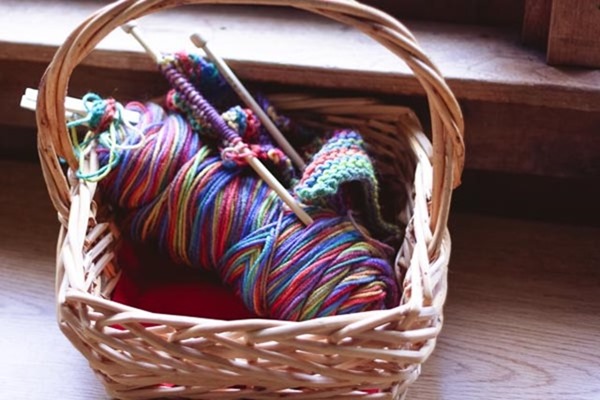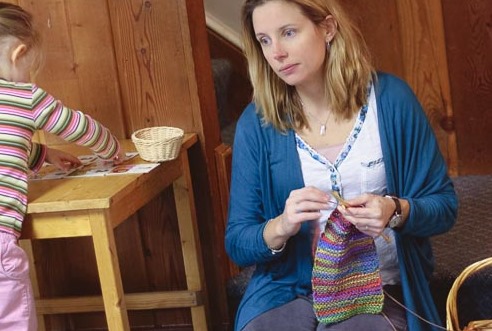I long to be able to knit — sweaters for my children, shawls, hats, and mittens — but I knit squares and rectangles. I can’t count stitches, I need to look up directions any time I have to do anything beyond a regular knit stitch. But recently, I dug up two matching needles (which was quite a feat in my house) and a variegated skein of yarn, I cast on, grabbed a basket and I started knitting.
I am not knitting curled up on my couch with a cup of coffee, I am knitting in my classroom. I am doing my work.
As my work can attest, I am not staring at the needles when I knit, I look down for a second when I start the stitch, and then I am scanning the classroom. It is amazing that there is always space to sit near the child or children that are a little unsettled.
I am modeling work, respect, concentration, commitment to a project. How’s it going? Some days better than others. There are days where I don’t have a second to take my work off the shelf and do a row, other days where I can sit and knit for what seems like ages (but is really about 5 minutes).
My work
Sometimes it is good for the teacher or parent to be occupied. I can’t hop up and assist every time I am needed. When I am in the middle of a row, and a child places their hand on my shoulder, I ask them what they need (to make sure that it is not urgent) and then I let them know that I am doing my work, and that I am sure they can solve their problem, or get their work started, or if they really need me, they can wait until I am done with my row.
Modeling what work is is an important factor in normalizing the process. Allowing the children to hear the language of “I am in the middle of my knitting work right now, I will be available in a little while” gives them the language and again, through our words we normalize the activity – I do my work, I can concentrate and focus on my work.
Respect
Our class has children that are still learning to respect others works. I can understand that it can be hard for the child to not touch the 1,000 chain when it is spread out across the room, “pausing” my knitting (or really just sticking my needles into the skein and tucking it next to a table, allows children the opportunity to practice self-discipline. Will I be mad and yell if a child unravels all the knitting, no, and just like we help the children work through their problems in the classroom, I will explain how I feel (sad because I have been working so hard) and then what I need to feel better (help winding the yarn back on the skein).
Concentration
Sometimes the hardest, loudest, most squirrely days are the days when I need to sit down and observe/work. When we do large group activities (rainy day dancing, paper plate pushing, playing instruments) sometimes the stop cue is to notice when the teacher simply stops and puts her hands up, the children copy by also stopping and putting their hands up. The children have to be aware of more than just themselves, there won’t be a chime or the music won’t stop to let them know what to do. All it takes is the first child to see the teacher stop and put her hands up, and then it is a snowball effect, all the children have stopped and have both hands up. That was a long way of explaining, I think the same principle applies to working. If the class seems unsettled, often, we simply sit down. It is easier to say than do. I find if I take out my knitting and I am working, it has the same effect as the stop cue, teacher works, others start to notice and start working. It is not an instant hum of purposeful activity, but it is a start and it helps me calm myself and think about what I need to do.
Commitment
It’s going to take a while to turn this knitting into a scarf. My hope was that I would have a few ready to sell at my school’s craft fair in February, at this rate I might just have half a scarf. But almost every day I take out my basket, even if it is just for two rows. And, even if it isn’t finished until May, I will keep taking it out and knitting.
Sometimes new works seem big and overwhelming to a child. Working on my knitting, just a little bit, every day, demonstrates commitment. We do allow our children to pause works. Meaning they place their name tag on the work they were doing if (1) they need a little break and want to have snack or do another work, or (2) it’s the end of the morning work cycle and they are not ready to clean up. If a work is paused, they have to come back and finish it in the near future, it can’t be an indefinite pause. Placing their name tag on the work is their commitment to finish, it is a way for them to practice executive planning, “Since it is time to go outside, I am going to finish counting the 9 long chain tomorrow morning.” My never-ending scarf is a reminder that sometimes, work takes a long time, but we keep on going.
Want to be the first to know what’s happening at montessori works? Sign-up to have posts delivered by email and never miss a thing!
[mc4wp_form]



I love this!
I was always fascinated that Maria Montessori also did work while teaching. You read about her doing weaving while in the class. Given me good idea, as I have been thinking about making felt food. Great to do these projects while in class, so children can see us working too.
Oh, right. The “sit down when things get zoo-y” plan. Just the reminder I needed this week.
There seems to be some valid points around childrens being made aware that they cannot always have an adults immediate attention however linking it to a teacher’s wish to knit in class is somwhat tenuous. I was a headteacher and would not appreciate a teacher sitting in class knitting or involved in any personal project when employed to give full attention to the children in class.
Artists in residence doing their own work is something for older children or higher education.